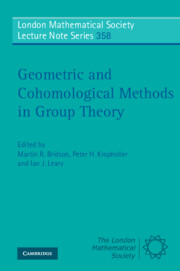Book contents
- Frontmatter
- Contents
- Preface
- List of Participants
- Notes on Sela's work: Limit groups and Makanin-Razborov diagrams
- Solutions to Bestvina & Feighn's exercises on limit groups
- L2-Invariants from the algebraic point of view
- Constructing non-positively curved spaces and groups
- Homology and dynamics in quasi-isometric rigidity of once-punctured mapping class groups
- Hattori-Stallings trace and Euler characteristics for groups
- Groups of small homological dimension and the Atiyah conjecture
- Logarithms and assembly maps on Kn(Zl[G])
- On complete resolutions
- Structure theory for branch groups
Solutions to Bestvina & Feighn's exercises on limit groups
Published online by Cambridge University Press: 07 September 2011
- Frontmatter
- Contents
- Preface
- List of Participants
- Notes on Sela's work: Limit groups and Makanin-Razborov diagrams
- Solutions to Bestvina & Feighn's exercises on limit groups
- L2-Invariants from the algebraic point of view
- Constructing non-positively curved spaces and groups
- Homology and dynamics in quasi-isometric rigidity of once-punctured mapping class groups
- Hattori-Stallings trace and Euler characteristics for groups
- Groups of small homological dimension and the Atiyah conjecture
- Logarithms and assembly maps on Kn(Zl[G])
- On complete resolutions
- Structure theory for branch groups
Summary
Abstract
This article gives solutions to the exercises in Bestvina and Feighn's paper [2] on Sela's work on limit groups. We prove that all constructible limit groups are limit groups and give an account of the shortening argument of Rips and Sela.
Mladen Bestvina and Mark Feighn's beautiful first set of notes [2] on Zlil Sela's work on the Tarski problems (see [10] et seq.) provides a very useful introduction to the subject. It gives a clear description of the construction of Makanin–Razborov diagrams, and precisely codifies the structure theory for limit groups in terms of constructible limit groups (CLGs). Furthermore, the reader is given a practical initiation in the subject with exercises that illustrate the key arguments. This article is intended as a supplement to [2], to provide solutions to these exercises. Although we do give some definitions in order not to interrupt the flow, we refer the reader to [2] for all the longer definitions and background ideas and references.
Definitions and elementary properties
In this section we present solutions to exercises 2, 3, 4, 5, 6 and 7, which give some of the simpler properties and the first examples and non-examples of limit groups.
- Type
- Chapter
- Information
- Geometric and Cohomological Methods in Group Theory , pp. 30 - 62Publisher: Cambridge University PressPrint publication year: 2009
- 8
- Cited by

